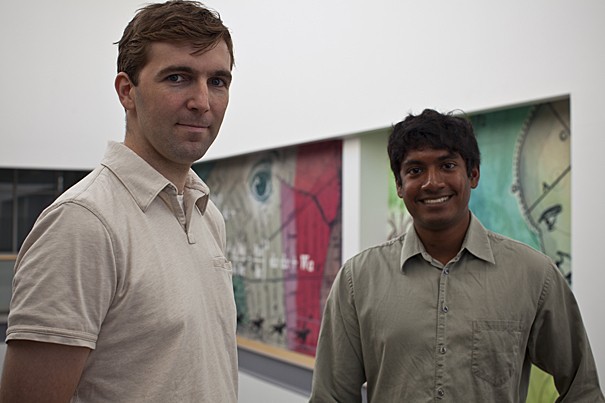 |
|
Photograph http://popularkinetics.wordpress.com/category/pop-up-books/ |
 |
|
Rob Wood and Pratheev Sreetharan. Photograph Justin Ide, Harvard News Office. http://www.seas.harvard.edu/news-events/press-releases/sreetharan-named-to-tr35 |
A pioneer of pop-up robotics, Pratheev Sreetharan, an American Tamil Harvard graduate, has been named as one thirty-five of the world's top innovators under the age of 35 by Technology Review magazine published by MIT.
A panel of expert judges and Technology Review editorial staff selected Sreetharan from over 300 nominees, for his work in the development of a new technique that allows the mass-production of tiny robotics from a sheet, that would have previously had to have been painstakingly assembled by hand.
The technique was developed alongside his co-developer, Rob Wood, a Charles River Professor of Engineering and Applied Sciences at SEAS, who himself won the under 35 top innovator accolade by Technology Review in 2009. The panel also noted Sreetharan's contribution to the creation of a millionth-scale differential that would oversee the flight of tiny aerial robots.
 |
|
Photograph http://www.seas.harvard.edu/news-events/press-releases/pop-up-flying-robots |
Sreetharan's leading prototypes is a robotic bee, or 'Mobee' - the Harvard Monolithic Bee. The size of a US quarter, the robotic bee can be created in a day from a miniscule icosahedron and a small chain of interlocking carbon-fibre links, the technique used is hoped to pave the way towards the manufacture of items between the micro-metres of silicon chips and the centimetre scale of ordinary objects - a gap that is vital in the development of medical and biological technology.
Inspired by children's pop-up books and origami paper creations, Sreetharan's pioneering technique began by adapting pre-existing methods used in circuit board manufacturing that allow parts to be created from a flat sheet, and went onto designing parts that pop-up from the flat surface and lock into place.
Talking about the success of the robotic bee earlier this year, Sreetharan said:
"This takes what is a craft, an artisanal process, and transforms it for automated mass production."
"Until recently, the manual assembly process was the state of the art in this field. You'd take a very fine tungsten wire and dip it in a little bit of superglue. Then, with that tiny ball of glue, you'd go in under a microscope like an arthroscopic surgeon and try to stick it in the right place."
Sreetharan, who did his undergraduate degree in Physics at Harvard College and graduated this year with a doctorate in Applied Physics from the Harvard School of Engineering and Applied Sciences (SEAS), recently spent a summer in Tamil Nadu, teaching in Tamil refugees from the North-East of Sri Lanka about renewable energy and designing a solar-powered computer charger, and has founded Vibrant Research in Cambridge, Massachusetts, as a platform to further his innovation.
